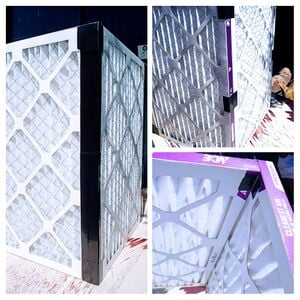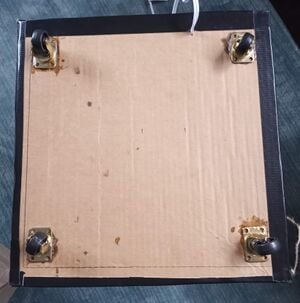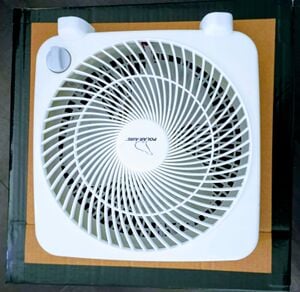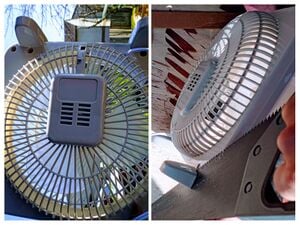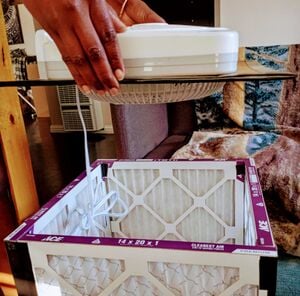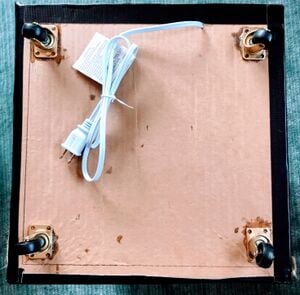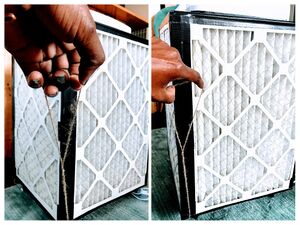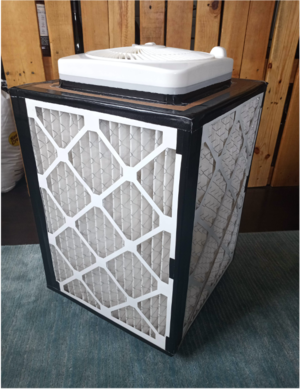
For the Spring 2021 class project of the Engineering 535, Development Technology class at Cal Poly Humboldt, we were tasked with designing, building and testing an affordable and easily replicable wildfire smoke mitigating air filtration system for low income families or individuals. The Do It Yourself (DIY) air filter was deigned to efficiently filter particulate matter in wildfire smoke and PM 2.5 (particulate matter 2.5) from other indoor pollutants. The ease of use for people with physical disabilities was also considered as seen in the inclusion of swivel caster wheels at the bottom of the air filter. The efficiency and cost effectiveness of the DIY air filter was found to be equivalent to that of a typical off the shelf air filter system.
Materials used[edit | edit source]
Essential materials[edit | edit source]
- 4 Pieces of ACE 14*20*1 inche high performance pleated air filters with a MERV13 rating
- 1 Piece POLAR-AIRE Household 9" Personal Fan
- 2 Pieces of hard cardboard
- 1 Roll Duct Tape
Additional optional materials[edit | edit source]
- 4 pieces swivel caster wheels
- 1 piece long fiber string
- 1 Gorilla Glue
- I small piece of rubber
Required tools[edit | edit source]
A pair of scissors, a marker or pencil and a hand saw.
Required skills[edit | edit source]
Anyone who can safely use the above tools.
A step by step construction procedure[edit | edit source]
Cutout two cardboard or hard boxes in a square shape, measured to the size of the bottom or top part of the filter housing.
Use a handsaw to cut off the extra box fan stand length at the bottom, on the air inflow side of the fan to ensure that the fan can fit well in the circular hole on the hard box cutout. This step is only necessary if you are using the same type of fan.
Insert the circular middle part/airway of the fan through the hard box cutout. Make sure it is tight in the circular cutout hole. Make sure the fan is inserted with the air outflow on the outer top and inflow on the inner side of the filter housing. User duct tape to further secure the fan on the card board without blocking the fan airway.
Cover the top of the filter housing with the hard box cutout that has the fan inserted in it. Ensuring that the fan switch and the air outflow are on the outer side of the filter housing, use duct tape to secure the cardboard with the fan on top of the housing, leaving no air spaces that are not part of the fan.
Check to see if the Gorilla Glue on the swivel caster wheels is dry and that they are secured on the hard box. If dry, make a one inch (1") slice on the side of hard box that has the wheels, enough to take the fan power cord through from the inside of the housing. Take the power cord through the slice and secure the slice with duct tape if needed.
To block off the bottom part of the filter housing, use duct tape and secure the cardboard with the strollers at the bottom of the filter housing, making sure that the wheels and the fan power cord are on the outer part of the bottom of the filter housing.
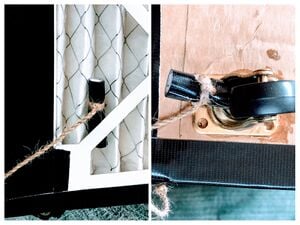
If your wheels don't have breaks, cut a small piece of rubber or styrofoam, tie it to a string, secure it at the bottom of the housing near one of the stroller to create a make shift break such that the filter doesn't keep moving when you don't want it to.
Note[edit | edit source]
- This air filtration system was designed to be used by people of different physical and economic ability.
- The air filtration system is designed to trap particles down to 0.3 microns including dust, pet dander, pollen, dust mite debris, mold, bacteria, microscopic allergens, virus, and smoke smog.
- The DIY air filtration system is four sided to allow use in different conners and room sizes and shapes such that the filtration process is not compromised by the area where it is being used.
Caution[edit | edit source]
- Remember to change your filters when they get dirty.
- Estimated time of use before changing the filters was not measured.
- For more information on how to safely and effectively use this DIY air filter, please see the user manual below.
User Manual[edit | edit source]
Other safety and user tips[edit | edit source]
- Reduce the strain on your filter by ensuring minimal polluted air entry into the house, especially during wildfire season
- If you have one filtration system, prioritize use for those that need it the most i.e., people with respiratory health problems and children.
- Do NOT kick your filtration system to move it.
- Keep it in dry clean place when not being used.
- It is better to buy the necessary materials required during the low season i.e., out of wildfires season.
